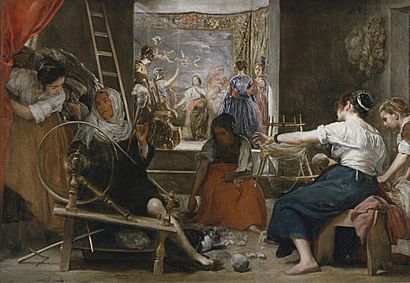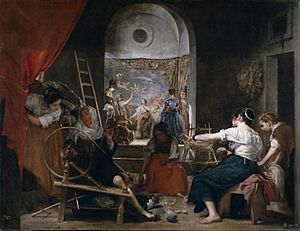Las Hilanderas facts for kids
Quick facts for kids Las Hilanderas |
|
|---|---|
 |
|
| Artist | Diego Velázquez |
| Year | c. 1657 |
| Medium | canvas |
| Dimensions | 220 cm × 289 cm (87 in × 114 in) |
| Location | Museo del Prado, Madrid |
Las Hilanderas is a famous painting by the Spanish artist Diego Velázquez. Its name means "The Spinners" in Spanish. You can see it at the Museo del Prado museum in Madrid, Spain. This painting is also known as The Fable of Arachne. Most experts believe Velázquez painted it around 1657-1658. It is one of his most important works.
Contents
About Las Hilanderas
Las Hilanderas is considered one of Velázquez's greatest paintings. It is a large and complex artwork. It was painted around the same time as his other famous work, Las Meninas. These two paintings show how skilled Velázquez was in creating big, detailed scenes.
The Story Behind the Painting
For a long time, people thought this painting showed women working in a tapestry workshop. But in 1948, an art expert named Diego Angula suggested a different idea. He believed the painting told the story of Arachne from ancient Greek myths. This story comes from a book called Metamorphoses by Ovid.
Arachne's Challenge
The myth tells of Arachne, a very talented weaver. She was so good that she dared to challenge the goddess Athena to a weaving contest. Athena was the goddess of wisdom and crafts. Arachne won the contest, which made Athena very angry. Because of her jealousy, Athena turned Arachne into a spider. This is why spiders spin webs. Today, most people agree that Velázquez's painting shows this famous myth.
What the Painting Shows
Velázquez used a special way to arrange the painting. He created different layers, like a stage play.
The Foreground Scene
In the front part of the painting, you see the weaving contest itself.
- On the left, the goddess Athena is disguised as an old woman.
- On the right, Arachne is shown from behind, wearing a white top.
- Three helpers are also in this area, assisting the weavers.
The Background Scene
In the back of the painting, there is a raised area, like a small stage. Here, you can see the finished tapestries. The one that stands out is Arachne's tapestry. It shows another Greek myth called "The Rape of Europa." This part of the painting is actually a copy of a famous work by the artist Titian. Titian's painting was part of the Spanish royal art collection.
Meanings of the Painting
Many people have tried to understand the deeper meaning of Las Hilanderas.
- Some think it is an allegory about art itself. They believe the goddess Athena represents the "fine arts," which need great ideas. Arachne, with her amazing weaving, represents "crafts" or hard technical work.
- Other experts believe Velázquez was simply showing that to create amazing art, you need both brilliant ideas and a lot of hard work.
- Some even see political messages or connections to popular culture in the painting.
History of the Painting
The painting was made for a man named Don Pedro de Arce. He was a huntsman for King Philip IV. Later, the painting became part of the Spanish royal art collection. It might have been damaged in a fire at the Royal Alcazar of Madrid in 1734. After the fire, new sections were added to the sides and top of the canvas. The painting is still this larger size today. However, it is often displayed in a way that shows only its original dimensions.
See also
 In Spanish: La fábula de Aracne para niños
In Spanish: La fábula de Aracne para niños


